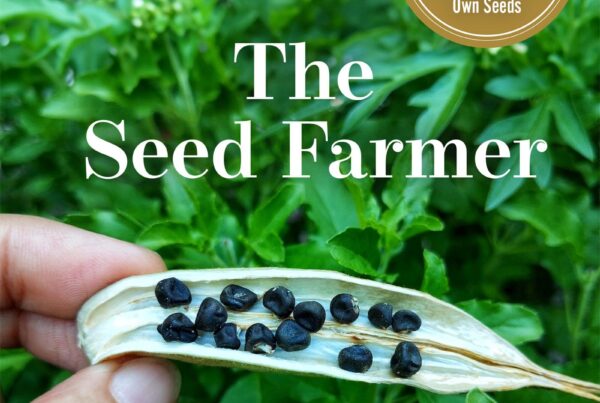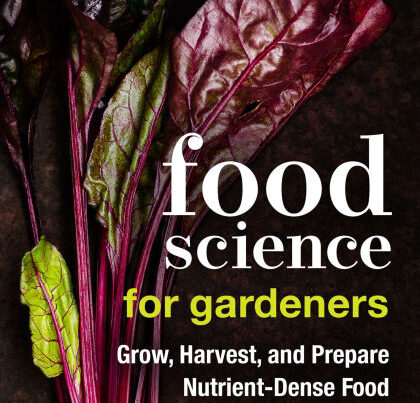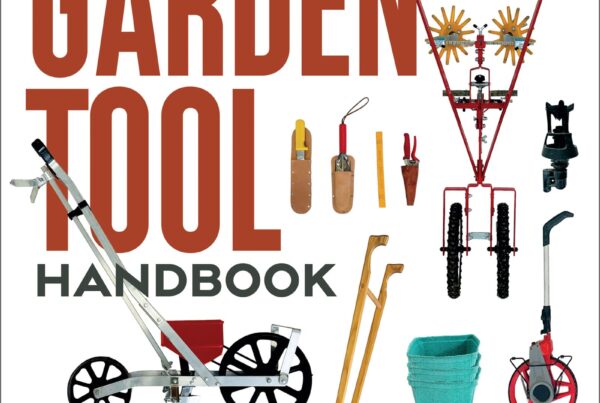Nancy Bubel with Jean Nick, 2018, 452 pages
Book Review by Pam Dawling, Author of Sustainable Market Farming: Intensive Vegetable Production on a Few Acres, and The Year-Round Hoophouse: Polytunnels for All Seasons and All Climates
This 2018 edition is an updated version of the old favorite 1988 reference book by Nacy Bubel explaining how to start seeds and grow healthy seedlings of vegetables, fruits, herbs, flowers, trees and shrubs; how to tackle seed-starting problems, and where to find seeds and gardening supplies. It includes an encyclopedia section listing more than 200 plants, with details on how to start each kind from seed. The 1988 book has been a very trusted resource for me for over 30 years, particularly the tables, which have information I found nowhere else in the pre-internet days. The newer version is not much changed. It has a retro cover and is labelled as a Rodale Classic. Some post-1988 tools and resources are included, and the trend towards smaller households is taken into account. The delightful drawings by Frank Fetz remain. It has a few black-and-white photos, although the cold frame photo in my copy is rotated 90°! This is a book primarily for backyard gardeners, but there is valuable information for growers on much bigger scales, especially in the tables.
Jean Nick is a longtime organic gardener, sustainable farmer, environmentalist and freelance writer and editor. Jean keeps the voice of Nancy Bubel, so the updates blend in smoothly.
If you have the original (1978) Seed-Starter’s Handbook, you’ll have missed all the improvements Nancy Bubel made during the ten years before The New one came out. If you have the 1988 edition and have kept up a bit with gardening topics, I doubt you need to buy the 2018 edition. If you are a relatively new grower, and Nancy Bubel’s work is new to you, I recommend buying this book for its broad collection of information and clear tables, drawings and explanations. Some of the tables come from Knott’s Handbook for Vegetable Growers, now a $90 investment.
The table of temperatures needed to kill soilborne pests is the first example of the feature of the book that I have turned to most often over the years. There is now an expanded table of when to start various seedlings and when to plant them out, referenced to your average last spring frost. The sowing checklist has been tidied into a more logical order. This book includes gems of information such as how to break seed dormancy with cold or light. Germination of onions and chives appears to be retarded by exposure to light, but lettuce and celery germination is helped by light if the temperature is higher than that at which they normally germinate best.
The chapter on light has been brought forward to a better place in the book, before seeds are sown. The science of lighting has changed since 1988, with different types of lighting available and newer information on what plants need, and do best with. Incandescent lights have gone, LED lights and high-intensity discharge lamps have arrived. Here’s a chapter where revision is really valuable, not forgetting that dusting light tubes and bulbs still makes a difference, and plants short of light still do better if the temperatures are cool.
Here’s another aspect of Nancy Bubel’s writing that I appreciate: the scientific explanations of how biological changes happen. For example, in the process of germination, starches and proteins change into simpler forms before they can dissolve in water and become available to the germinating seed. The enzymes needed to split the complex molecules into simpler ones act in response to the increasing respiration of the seed as it breaks dormancy. Reality check: Even dead seeds can absorb water: plumped-up seeds are not proof of life.
Next come my three favorite tables (copies of which are posted on our germination cabinet): Ideal Temperatures for Germination of 27 crops; the Number of Days to Germinate at Various Temperatures from freezing point to 104°F (40°C); and The Percentage of Normal Vegetable Seedlings Produced at Different Temperatures. This is where I learned that you might get spinach to germinate at 68°F-86°F (20°C-30°C), but you’ll get decreasing levels of normal seedlings, down to one third. These three tables enable growers to aim for the ideal temperature, know when to resow if nothing has come up, and the unintended consequences of sowing crops too far outside their optimal range.
Start seeds warm and grow seedlings cool. Chill tomato plants as soon as the seed leaves open, to get earlier and heavier fruiting: keep them at 52°F-56°F (11°C-13°C) for 10-21 days. The construction of the first flower cluster is determined 4-6 weeks before flowering, when the seed leaves just opened. Similarly for peppers. Many of us have accidentally achieved these results when we started those crops extra early and they emerged into a chilly greenhouse.
.
Nancy Bubel collected moss from her woods, tore it up and lined the base of pots and flats. Those of us who know how slowly mosses grow will not follow that advice, and Jean Nick marks it as optional. Our increased awareness of the importance of sustainability, and of the carbon-sequestering role of peat moss left me surprised to see that although there is an unflinching discussion of the issues, sphagnum moss and peat moss are still recommended. Worm castings, composted bark, coir and rice hulls are listed as alternatives, without discussion of the ecological costs of removing agricultural “waste products” across half the globe to another country.
The Growing On chapter has information about watering and fertilizing (soaking eggshells in water as a fertilizer has been dropped). The importance of air movement has been added. Next are preparations for moving your plants outdoors. This starts with knowing suitable conditions for working up the soil, and how to make life easier by using permanent beds where the soil stays loose. Jean Nick has added information on soil structure and the mycorrhizal fungi that associate with many crops, improving the soil structure. Double-digging has been back-burnered. Tilling and digging break up the mycorrhizae, so doing less tillage is advantageous, as is growing a diversity of plants in close association, and keeping live roots in the soil. Options for ways to start a new garden are explained, including sheet mulching.
The chapter on the garden diary has been moved forward, so we learn about it before we start planting outdoors, and a short paragraph about calendar apps, photo records and blogs has been added. Garden Mapping comes next, with a two-plus page table of recommended inter-plant and inter-row spacings. A paragraph about modern weather-forecasting has been added, with advice to take the time to pay attention to local weather and microclimate. This chapter includes choosing suitable weather conditions, time of day and suitable sized plants, and developing good judgement, green thumbs and good planting techniques.
The 1988 version of this book was where I learned about phenology, studying the cycles of development of living things unfolding through the year, and linking various agricultural events with particular natural developments. There is much in the encyclopedia section. Spring peepers start really early, and rather than being a sign to plant something, they can be a sign to look for soil dry enough to till. I also found value in the list of conditions that mean a frosty night is likely.
The chapter on care of young transplants includes mulching, but no longer recommends old carpets (synthetic these days, not wool), and adds in paper roll mulch, biodegradable and other plastic sheet mulches. Protection for new transplants has changed from tall bushel baskets to floating row cover. Glass cloches have been replaced by water walls (double walled containers to set round the plants and fill with water for insulation) and plastic gallon jugs with the bottoms cut out. The chapter on cold frames and hotbeds has been moved later and been combined with info on greenhouses. Most of the rearranging of chapters makes sense timewise, but this one was counter-intuitive for me.
Kelp sprays help plants resist frosty temperatures: tomato plants survive 29°F (-2°C). Celery plants sprayed at 20 days after emergence with a 1:100 solution of seaweed extract grew larger stalks than untreated plants. Snap beans sprayed with seaweed one week before bloom gave a 10% yield increase on the first picking. Weekly spraying of cucumber plants while fruiting increased the harvest by almost 42% in a 3-year study. I’m leery of spraying anything on cucurbits, as I’ve had problems that way. This book has how to make your own kelp spray from scratch. For those near the sea. Compost tea and comfrey tea have been added as fertilizers. Here’s how to make them. True compost tea is aerated while brewing. With all these concoctions, be sure you start with healthy ingredients, to avoid brewing more bad germs, which could make you ill.
The chapter on fall gardening includes a useful table on determining your last planting date for many crops, taking account of cold-hardiness, days to maturity, days to transplanting, 14 days for the “short day factor” (because daylength is shortening), and 14 days to allow for the possibility of an early frost. The combination of these factors tells you how many days to count back from your average first frost date.
Up next are pests, both insects and other animals. The newer edition has helpful damage-reducing advice using methods causing minimal collateral damage: using row cover, spraying fairly hard with water, homemade garlic and cayenne sprays, neem oil, insecticidal soap, and Bt for suitable insects. Those instructions are followed by specific info for particular pests.
The section on hoophouses says to build your own from metal conduit and builders’ plastic, although the following paragraph says that kind of plastic will disintegrate in 6 months (and be cloudy before that). If you’ve ever gathered up plastic shards from your garden, you won’t use builders’ plastic again! Solar greenhouses can be an attractive idea, but you can get the same space in a hoophouse (high tunnel) compared to a greenhouse, for a quarter of the cost. Because the structure of a high tunnel is less massive than a glass-covered greenhouse, more light reaches your crops in a high tunnel, and growth is faster.
The chapter on greenhouse growing covers temperature and humidity and when to start seedlings. Humidity of 45-60% works well, even 70%, but 90% is too damp, and may lead to fungal diseases and algal growth. The plant diseases section includes growing conditions less likely to promote diseases, choosing resistant cultivars, monitoring plants, practicing good sanitation, and providing airflow.
“Why seed saving and storing are important” has been moved forward in the 2018 edition, sending the wildflowers and trees back into the encyclopedia part of the book with other specific crops. Before starting to save seeds, understand how seeds form. A new sidebar explains how to avoid GMO cross-pollination. Understanding seed isolation is also useful since the arrival of Super-sweet corns, which need to be isolated from all other types of corn. Likewise, this will help in understanding squash pollination groups and brassica families.
Next is information on how to develop a crop strain suited to your locality. Here is an explanation of what a hybrid is, and why saving seeds from hybrids is challenging, produces seeds inferior to your starting material and doesn’t lead to quick improvements. “You have more to lose than to gain from saving seeds of garden hybrids.” Nancy Bubel.
When harvesting a seed crop, it’s important they are mature. Here’s brief info on cleaning, sorting, drying and winnowing, salt-water treatment, hot water treatment and fermentation to kill seedborne diseases.
Seeds need to be very dry when put into storage and after that. No paper packets on shelves! Between 32°F and 112°F (0°C – 44°C), for every 9F (5C) that the storage temperature is lowered, the duration of viability of the seeds is doubled. Increasing the moisture content of lettuce seeds by 5-10% results in a faster loss of viability than increasing the storage temperature from 68°F (20°C) to 104°F (40°C)! The sum of the humidity and the temperature in °F should be less than 100.
The chapter on viability of seeds includes how to test germination rates, and a money-and-time-saving table of how many years after production each kind of vegetable seeds will last. The table is from the 1980 Knott’s Handbook for Vegetable Growers and is unchanged. This is followed by seed-saving tips for specific plants, and tips for plant breeding, such as how to hand-pollinate, save pollen for later, and how to sell your seeds or plants.
Seed banks are valuable resources for preserving genetic diversity and distributing seed genetics widely. They provide resilience in the face of disasters such as new diseases or calamities at a particular seed warehouse. Their work is valuable in keeping genetic material available to all, not just in the hands of multinational corporations.
Most of the rest of the book is an encyclopedia of plants to grow from seed. The detailed information relates to temperature and phenology, not the calendar. This is a great source, that will help you try new crops that previously might have struggled in your bioregion, especially if you only had planting dates, not conditions.
Here are some examples: Sow parsnips when the daffodils bloom; sow peas up until 2-3 weeks before the last frost (after that there is not enough cool weather left to mature a good crop); sow chard when maples bloom; edamame when apple blossom starts to fall or when the oak leaves are the size of mouse ears; sow asparagus seed in spring at the same sign as edamame, or in the fall. Sow peanuts when maple leaves are the size of squirrels’ ears; adzuki beans when the soil temperature is above 60°F (16°C); Lima beans when the soil is at least 70°F (21°C), when peonies are in full bloom; sow winter squash and pre-sprouted cucumber seeds when the late irises bloom; plant out tomatoes when you’re fairly sure your last frost has passed, about the time the barn swallows return.
To my surprise, the book recommends growing potatoes from spuds left from last year’s crop. I wouldn’t do this because of the diseases that can spread.
After the vegetable and fruit section are chapters on growing herbs, garden flowers, wildflowers, trees and shrubs from seed. This is where I learned to nick redbud seeds, pour boiling water on them and let them soak for a day to break dormancy. The newer edition has a sidebar on invasive trees and shrubs, and advocates for responsibility in what we plant and what we let grow. The updated list of sources of seeds and supplies includes websites and phone numbers. There’s a 23-page index (considerably fuller than the earlier edition).
Nancy Bubel wrote a great book, including very accessible information not found in many gardening books. If you have not got the previous edition, do buy the 2018 one. If you still have the previous one, and access to other books and the web, I would not rush to buy this edition – not so much is new.







